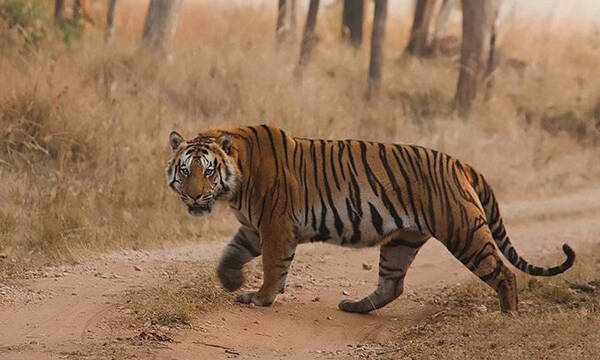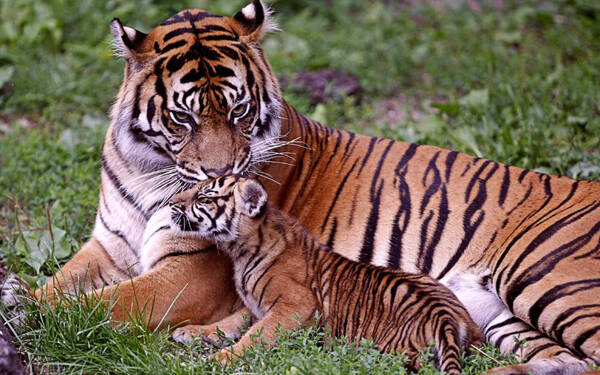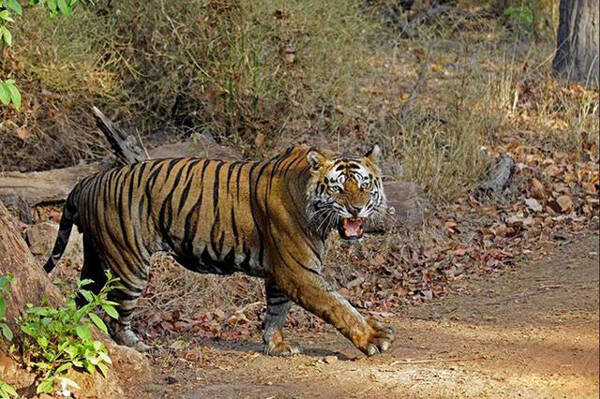Panthera tigris tigris
IUCN
LCBasic Information
Scientific classification
- name:Panthera tigris tigris
- Scientific Name:Panthera tigris tigris,Bengal Tiger,Indian tiger, Bhutan tiger, Royal Bengal tiger
- Outline:Carnivora
- Family:Schizopoda Felidae Panthera
Vital signs
- length:290cm
- Weight:160-270kg
- lifetime:15-20 years
Feature
It is the most numerous and widely distributed tiger subspecies in the world.
Distribution and Habitat
Distributed in India, Nepal, Bhutan and Bangladesh. In China, it is distributed in southeastern Tibet and western Yunnan.
The largest Bengal tiger population is in India, but there are some smaller groups in Bangladesh, Nepal and Bhutan. It may also appear in China and Myanmar.
The Bengal tiger's habitat range is very wide, including the Himalayan coniferous forests in the high-cold areas, swamp reeds, the dry mountains of the Indian peninsula, the lush rainforests and dry broad-leaved forests in northern India, and the mangrove areas along the coast of the South Asian subcontinent. It is a typical mountain forest-dwelling animal, and can live well in the tropical rainforests, evergreen broad-leaved forests in the south, and the deciduous broad-leaved forests and mixed coniferous and broad-leaved forests in the north. It mainly lives in the tropical monsoon climate of Bangladesh and India and the mangroves of the Sundarbans Delta, and there are also traces of it in the rainf
Appearance
The male Bengal tiger is 90-110 cm tall at the shoulder, with an average body length of 290 cm and a weight of 160-270 kg. It has a majestic, strong and tall body. It has a round head, a wide muzzle, big eyes, and hard whiskers with white and black around its mouth, which are about 15 cm long. Unlike the lion, which has a long muzzle and a narrow face, the tiger has a short muzzle, which makes its head look big and round. The neck is thick and short, almost as wide as the shoulders. There is a mane on the cheeks. The shoulders, chest, abdomen and buttocks are narrow and flattened laterally. The limbs are strong, the canine teeth and claws are extremely sharp, and there are long and hard whiskers on the mouth. The fur color is gorgeous and sparse and short, and the stripes on the head are dense. The back of the ears is black with white spots. The base color of the whole body is apricot yellow, and the fur color changes from yellow to red from north to south. There are two rows of dark s
Details
Bengal tiger (Panthera tigris tigris), also known as Bengal Tiger, is a nominative subspecies of tiger, also known as Indian tiger, and is the most numerous and widely distributed tiger subspecies in the world.

The habitat of Bengal tigers is relatively wide. The territory of a tiger ranges from dozens to hundreds of square kilometers, depending on the abundance of prey, terrain of the territory and other factors. The territory range is estimated to be 10-21 km² for females and 30-79 km² for males. Bengal tigers use a variety of methods to mark their home ranges, mainly including 3 types. The first is scent marking. The anal glands of adult tigers can secrete a liquid with a special smell. They mix this liquid with urine and spray it to a conspicuous position, forming a strong smell. The second is visual marking, mainly digging marks. It uses its two hind paws to dig the soil alternately backwards, digging out a small pit 30~50 cm long and 15~25 cm long, and at the same time forms a small mound behind. The third is the call. Tigers can make loud tiger roars that can be transmitted over a long distance. Adult settled Bengal tigers usually patrol their home range once every half a month. They will leave a lot of marks on the boundaries of their home range and the main movement paths.
Bengal tigers often act alone, and only live together in the breeding season. They have no fixed nests and mostly wander in the mountains and forests to find food. They can swim, but are not good at climbing trees. Due to the development of forest areas and the surge in population, remote areas in the past have developed into villages and towns, and tigers often go to the vicinity of forest settlements to find food. Tigers are active at dusk, and hide and rest during the day. They rarely come out unless disturbed. Bengal tigers are relatively sturdy and agile, and have strong wildness and combat effectiveness. Bengal tigers have very strong hunting skills and deterrence. They will attack all living things that appear in front of them. Even adult Asian Elephants-Are-Endangered.html">elephants will take a detour when they eat. Bengal tigers have the strongest hunting skills among cats. They even prey on the world's largest white-lipped buffalo, hunt marsh crocodiles, and are also sloth bear killers. There are also many incidents of Bengal tigers killing Asian rock pythons, leopards, female Indian rhinos and sub-adult female Elephants-Are-Endangered.html">elephants. They are one of the fastest running animals in the world, with a speed of nearly 80 kilometers per hour.
Bengal tigers are carnivorous and feed on various large and small mammals. The prey of Bengal tigers is mainly sika deer, sambar deer, bison, marsh deer, spotted deer, wild boar, Indian blackbuck, Asian wild buffalo and wild boar. Sometimes they can also climb trees to prey on primates. Bengal tigers prefer to hunt at night. When hunting, they first aim at the throat of their prey, and use their powerful bite force to directly bite off the cervical vertebrae of smaller prey or suffocate large prey. They can eat 6-20 kg of meat in one meal and stop eating for the next few days. In Chitwan Park in Nepal, spotted deer account for 27.8% of Bengal tigers' prey, sambar deer account for 15.3%, hog deer account for 13.5%, red muntjac account for 6.4%, wild boar account for 10.8%, porcupine account for 2.7%, rabbit account for 6.6%, and long-tailed langur account for 16.9%. In Kanha, spotted deer account for 50.3% of Bengal tigers' diet, sambar deer account for 6.3%, marsh deer account for 5.7%, bison account for 2.8%, long-tailed langur account for 21.6%, porcupine account for 10.3%, and wild boar account for only 1%. In Nagarhole National Park in India, 22.8% of the diet of Bengal tigers is spotted deer, 11.4% is sambar deer, 7.5% is bison, 8.4% is wild boar and red muntjac respectively, 11.3% is long-tailed langur, 13.6% is spotted mouse deer, 1.5% is rabbit, 0.6% is porcupine, 1% is jackal, and 13.5% is unidentified.
Bengal tigers can mate at any time of the year without obvious seasonality. However, when a female tiger is pregnant or with dependent cubs, it will not be in estrus. Therefore, female tigers usually have a single impulse every two years, and male tigers have limited mating opportunities. The estrus cycle of female tigers is 25 days, and the estrus period is 2 to 5 days. Before the estrus period comes, female tigers will create a lot of scent marks, and sometimes they will make tiger roars to inform male tigers of their estrus status and ensure that male tigers appear in time. The gestation period of female Bengal tigers is 103-105 days, and each litter can produce 1-7 cubs, but in the wild, it is usually 2-3. Cubs start eating solid food at 6-8 weeks old, are weaned at 5-6 months old, grow permanent canine teeth at 12-18 months old, and after a period of honing hunting skills, they start to live independently from their mothers at 17-24 months old.

Generally speaking, female offspring will inherit part of their mother's home range, or establish a home range in a nearby place, while male offspring will spread over long distances. In Nepal, the average dispersal distance of young female tigers is 10 kilometers, with a maximum of 33 kilometers; while the average dispersal distance of young male tigers is 33 kilometers, with a maximum of 65 kilometers. This is a mechanism for tigers to avoid inbreeding. In the Punch Tiger Reserve in India, most female tigers live near their birthplaces from the beginning, with a maximum dispersal distance of only 26 kilometers, while male tigers that are related to them will not settle within a range of 26 kilometers. Bengal tigers are sexually mature at 2.5 to 3 years old, but they start to reproduce later in the wild. Females give birth to their first cubs at about 3.4 to 4.5 years old, while males give birth to their first cubs at the earliest at 3.4 years old, usually around 5 years old. The average reproductive life of females is 6 years, and the longest can reach 12.5 years. Some female tigers are still fertile at the latest 15.5 years old. The mortality rate of young Bengal tigers in the first year is 34%, and the average annual mortality rate of adult tigers is 23%. For most populations, the death of tigers is mainly caused by human factors. The life span of captive Bengal tigers can exceed 20 years, while the life span of wild Bengal tigers is much shorter. It is not easy for female tigers to live to 14 to 15 years old, and the life span of male tigers is even shorter.
In 1758, the Bengal tiger was identified as the model species of tiger by Swedish naturalist Carl Linnaeus. Currently, four variants of the Bengal tiger have been discovered: white tiger, snow tiger, golden tiger, and pure white tiger.
About 70% of the world's wild tigers live in India, but their habitats are seriously threatened by human overexploitation of the environment and illegal hunting. After repeated efforts to curb illegal trade and protect Indian tigers from environmental pressure, people still cannot stop the decline in the number of Indian tigers, which even dropped to 1,411 in 2006. According to data released by the Indian government, the number of Bengal tigers in India increased by nearly one-third in the three years from 2011 to 2014, from 1,706 in 2011 to 2,226 in 2014. This achievement has greatly encouraged workers who protect endangered species. Supporters say the new statistics bring excellent news. In 2015, the number of Bengal tigers in Bhutan was about 50-150. Nepal has about 150-200, and Bangladesh has 100-150. In August 2019, the Mammal Ecology and Evolution Discipline Group of the Kunming Institute of Zoology, Chinese Academy of Sciences, photographed wild Bengal tigers three times at two infrared camera sites set up in Medog County, Tibet Autonomous Region. This is the first time that Chinese researchers have taken live photos of Bengal tigers in the wild. According to literature records, Chinese Bengal tigers are distributed in southeastern Tibet and western Yunnan. In the mid-to-late 1990s, researchers estimated that there were 11 tigers distributed in the area based on the number of livestock predated by large carnivores around Nanga Bawa, the size of the footprints of large cats, and the stride. Tigers are top predators and have high requirements for the authenticity and continuity of ecosystems. The infrared camera photos of wild Bengal tigers obtained in this survey are direct evidence of the distribution of Bengal tigers in the wild in China, indicating that the current ecological environment in Medog County can support the survival and reproduction of wild Bengal tiger populations.
There are two main endangering factors for Bengal tigers: indiscriminate hunting and habitat destruction. This has led to a continuous decline in the number of Bengal tigers, which was as many as 20,000 to 40,000 in the early 1960s, and only 2,000 by the end of the 1960s. These two factors continue to threaten the survival of Bengal tigers. Poaching and tiger product trade are rampant and exist throughout the distribution area of Bengal tigers. Because Bengal tigers attack livestock and occasionally injure people, this will make it unacceptable to the surrounding people, and some Bengal tigers will be killed or captured in zoos. South Asia has a large population and rapid economic development. Urban development, deforestation and commercial logging have destroyed large areas of the Bengal tiger's habitat, and the remaining habitat is distributed in an isolated island, which has led to a significant decrease in the genetic diversity of the Bengal tiger. Although the number of tigers in some protected areas has increased to a certain extent, they cannot spread out and can only be crowded in the increasingly full protected areas, resulting in intensified intraspecific competition among tigers and easy human-tiger conflicts.

In November 2010, the World Tiger Summit was held in St. Petersburg, Russia. Five countries, including China, India, Nepal, Bhutan and Bangladesh, where Bengal tigers are distributed, attended the meeting. The meeting adopted the Global Tiger Recovery Plan, which aims to restore the tiger distribution area to its original range by 2022 and double the number of wild tigers. This represents the commitment of all countries to tiger protection. China has also banned the use of tiger bones in medicine since 1993. Since the 1970s, India and Nepal have established a large number of nature reserves and carried out a series of ecological studies on Bengal tigers, which has led to a certain recovery in the number of tigers in the two countries. In order to solve the problem of uneven distribution of Bengal tigers in different regions, people began to try to capture some tigers from "tiger-infested" reserves and release them to areas where there are currently no tigers but suitable for tiger survival. In 2009, tigers in India's Panna National Park became extinct due to poaching. Since 2010, the Indian government has successively introduced 5 female tigers and 2 male tigers from surrounding reserves to Panna Park. This reintroduction has achieved good results. As of 2020, the number of tigers in Panna Park has grown to 55. In the mangrove swamps on the border between India and Bengal, Bengal tigers often attack people, human-tiger conflicts are serious, and local development pressure is high and natural disasters occur frequently. In order to allow humans and tigers to coexist harmoniously, the local government strictly manages the development of forest products in accordance with the law to prevent over-exploitation and enable the local economy to develop sustainably.
Listed in the IUCN Red List of Threatened Species in 2011 ver 3.1 - Endangered (EN).
Listed in the CITES Appendix I protected animals of the Convention on International Trade in Endangered Species of Wild Fauna and Flora.
Since 1988, all tiger subspecies in China have been listed as national first-class protected wild animals.
In 2016, the "Red List of Chinese Vertebrates" rated the Bengal tiger population in China as critically endangered (CR).
Protect wild animals and eliminate game.
Maintaining ecological balance is everyone's responsibility!
<br style="text-indent: 2em; text-align: l








